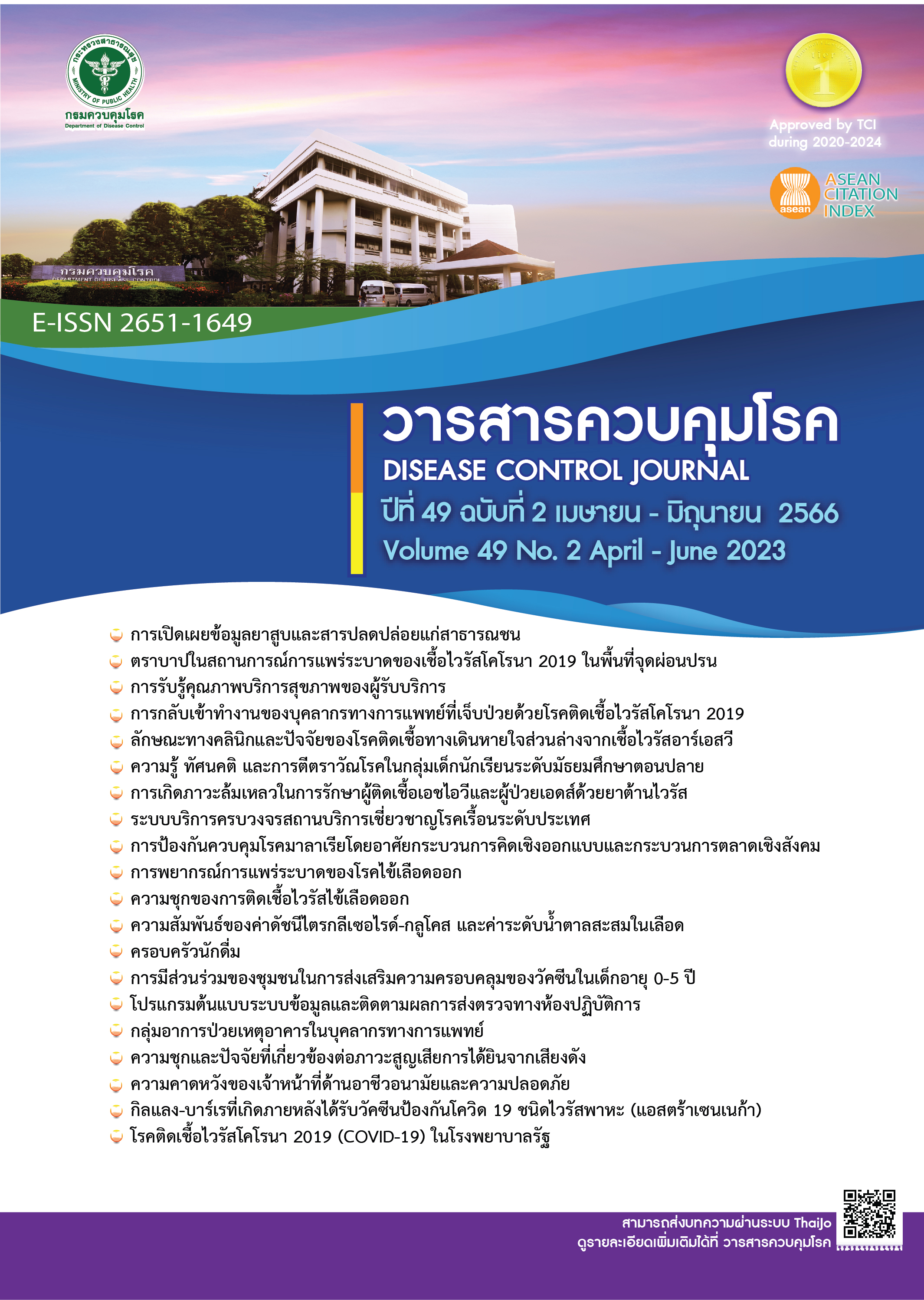Clinical Characteristics and Factors Associated with Severity of Lower Respiratory Tract Infection from Respiratory Syncytial Virus (RSV) in Pediatric Patients at Chaoprayayommarat Hospital
DOI:
https://doi.org/10.14456/dcj.2023.25Keywords:
Factors associated with severity, Pneumonia, Bronchiolitis, RSVAbstract
The lower respiratory tract infection (LRTI) caused by the respiratory syncytial virus (RSV) is a leading cause of hospitalization in children. This study aimed to determine clinical characteristics and factors associated with the severity of LRTI from RSV in children and recurrent wheezing at one year after RSV infection. This retrospective analytic cross-sectional study was conducted by reviewing the medical records of pediatric patients aged 0 to 6 years who have been diagnosed with LRTI from RSV. Specimens were collected from nasal cavity and tested using a rapid antigen detection test for RSV. These pediatric patients were admitted to the pediatrics department between October and December 2020. The patients were categorized into two groups: the severe group with pneumonia and bronchiolitis; and the non-severe group with bronchitis. Multiple logistic regression analysis was used to determine the factors associated with severity. The study found that, of the 157 children with LRTI from RSV, 102 (65%) had pneumonia and bronchiolitis, whereas 55 (35%) had bronchitis. Children aged below 6 months with RSV infection were 18.6 times more likely to develop severe disease than children aged 1-6 years (ORadj 18.6, 95% CI 2.37-145.71, p=0.005) and abnormal lung auscultation of wheezing was associated with the severity of RSV equal to 4.5 times (ORadj 4.5, 95% CI 1.68-11.93, p=0.003). This study demonstrated that children below 6 months old and those who had clinical pulmonary signs of wheezing were associated with the severity of LRTI from RSV.
Downloads
References
Perk Y, Özdil M. Respiratory syncytial virus infections in neonates and infants. Turk Pediatri Ars. 2018;53:63-70.
American Academy of Pediatrics. Respiratory Syncytial Virus. In: Kimberlin DW, Brady MT, Jackson MA, Long SS, editors. 2015 Red book: Report of The Committee on Infectious Diseases 30th ed. Elk Grove Village, IL: American Academy of Pediatrics; 2015:667-76.
Blau DM, Baillie VL, Els T, Mahtab S, Mutevedzi P, Keita AM, et al. Deaths attributed to respiratory syncytial virus in young children in high–mortality rate settings: Report from child health and mortality prevention surveillance (CHAMPS). CID. 2021;73(Suppl 3):S218-28.
Geoghegan S, Erviti A, Caballero MT, Vallone F, Zanone SM, Losada JV, et al. Mortality due to respiratory syncytial virus. Burden and risk factors. Am J Respir Crit Care Med. 2017;195:96-103.
Aikphaibul P, Theerawit T, Sophonphan J, Wacharachaisurapol N, Jitrungruengnij N, Puthanakit T. Risk factors of severe hospitalized respiratory syncytial virus infection in tertiary care center in Thailand. Influenza Other Respir Viruses. 2021;15:64-71.
Bunjoungmanee P, Rotejaratpaisan A, Tangsathapornpong A. Epidemiology, clinical manifestation and risk factors of respiratory syncytial virus infection in children at Thammasat University Hospital. Thammasat Medical Journal. 2016;16:370-8. (in Thai)
Murray A, Chu HY. RSV, antibodies and the developing world. Pediatr Infect Dis J. 2019;38 :S24-7.
Beckhaus AA, Castro-Rodriguez JA. Down syndrome and the risk of severe RSV infection: A meta-analysis. Pediatrics. 2018;142(3):e20180225. doi:10.1542/peds.2018-0225.
Ferolla FM, Soffe J, Mistchenko A, Contrini MM, López EL. Clinical and epidemiological impact of respiratory syncytial virus and identification of risk factors for severe disease in children hospitalized due to acute respiratory tract infection. Arch Argent Pediatr. 2019;117:216-23.
Pediatric Respiratory and Critical Care Medicine Society, The Royal College of Pediatricians of Thailand. Clinical practice guideline for management of acute respiratory infection in children. Nonthaburi: Beyond Enterprise; 2019. (in Thai)
World Health Organization. The management of acute respiratory infection in children. Practical guidelines for outpatient care. Geneva: WHO; 1995.
Srijareonvijit C, Umpornareekul S, Moolasart V. Clinical factors associated with respiratory syncytial virus-hospitalization among young Thai children. Thai Journal of Pediatrics. 2018;57:174-82. (in Thai)
Hair JF, Black WC, Babin JB, Anderson RE. Multivariate data analysis: A global perspective. 5th ed. Boston: Pearson Education; 2010.
Hosmer DW, Lemeshow S. Applied logistic regression. 2nd ed. New York: John Wiley & Sons; 2000.
American Academy of Pediatrics. Diagnosis and management of bronchiolitis. Pediatrics. 2006;118:1774-93.
Simões EAF. Environmental and demographic risk factors for respiratory syncytial virus lower respiratory tract disease. J Pediatr. 2003;143:118-26.
Sommer C, Resch B, Simoes EAF. Risk factors for severe respiratory syncytial virus lower respiratory tract infection. The Open Microbiology Journal. 2011;5:(Suppl 2-M4):144-54.
Restori KH, Srinivasa BT, Ward BJ, Fixman ED. Neonatal immunity, respiratory virus infections, and the development of asthma. Front Immunol. 2018;9:1249:doi:10.3389/fimmu. 2018.01249.
Ueno F, Tamaki R, Saito M, Okamoto M, Saito-Obata M, Kamigaki T, et al. Age‐specific incidence rates and risk factors for respiratory syncytial virus‐associated lower respiratory tract illness in cohort children under 5 years old in the Philippines. Influenza Other Respi Viruses. 2019;13:339-53.
Sigurs N, Bjarnason R, Sigurbergsson F, Kjellman B. Respiratory syncytial virus bronchiolitis in infancy is an important risk factor for asthma and allergy at age 7. Am J Respir Crit Care Med. 2000;161:1501-7.
Bønnelykke K, Vissing NH, Sevelsted A, Johnston SL, Bisgaard H. Association between respiratory infections in early life and later asthma is independent of virus type. J Allergy Clin Immunol. 2015;136:81-6.e4. doi: 10.1016/j.jaci.2015.02.024.
Downloads
Published
How to Cite
Issue
Section
License
Copyright (c) 2023 Disease Control Journal

This work is licensed under a Creative Commons Attribution-NonCommercial-NoDerivatives 4.0 International License.
Articles published in the Disease Control Journal are considered as academic work, research or analysis of the personal opinion of the authors, not the opinion of the Thailand Department of Disease Control or editorial team. The authors must be responsible for their articles.






